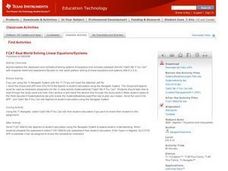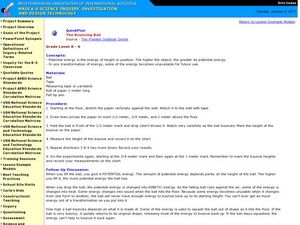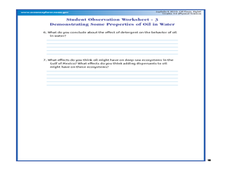Curated OER
FCAT Real World Solving Linear Equations/Systems
Pupils relate real life situation to the equations, graphs and inequalities. They model real life scenarios using matrices and draw conclusions from their data. This lesson plan is aligned with FCAT.
Curated OER
Living Conditions in Victorian Houses
Students interpret a painting and draw conclusions about life in 10th century Britain. In this British history instructional activity, students determine what life would have been like for an affluent British family including their...
Curated OER
Analyzing the Job Market for Babysitting in Your Neighborhood
Students conduct research on a neighborhood in Canada. In this data analysis lesson, students use data from the 2006 Canadian census to draw conclusions about a population group.
Curated OER
The Bouncing Ball
Students use the scientific method to conduct an experiment to test how a ball bounces. In this inquiry-based physical science and scientific method lesson, students drop a ball from specified heights and record the rebound, then record...
Curated OER
A Demonstration of Photo-and Geotaxes in Nauplii of Artemia Salina
Students explore phototaxis and geotaxis in brine shrimp. In this phototaxis and geotaxis lesson plan, students study the effects of light and gravity on brine shrimp using a test tube, a pen light and gravity. They answer questions...
Curated OER
The Properties of Air
First graders draw conclusions about the properties of air. In this properties of air lesson, the teacher demonstrates several properties of air and guides students through discovering that air is colorless, tasteless, odorless, exerts...
Curated OER
Air Pollution
Students collect and examine particulate matter found in the air. In this pollution activity, students use microscope slides and petroleum jelly to collect particulate matter from several different locations, then use a microscope to...
Curated OER
Popcorn Is a Gas
Students investigate why and how popcorn pops. In this gas lesson plan, students observe and make suggestions as to what causes popcorn to pop after observing popped corn and corn kernels. Students mass the kernels before and after...
Curated OER
Adhesives: How Sticky is Your Tape?
Students test the adhesive strength of different tapes. In this adhesive lesson plan, students conduct an experiment to test the shear strength of the adhesives, take measurements, record data, and draw conclusions to explain each...
Curated OER
Objects Race 500
Students explore the concept of "shape affects speed" through a series of experiments. In this physics lesson, students participate in an experiment in which various objects are released on an inclined plane. Speed and distance are...
Curated OER
Rotational Inertia
Students spin themselves to understand rotational inertia. In this Inertia lesson, students will also use ramps, balance beam and pendelum to conduct rotational inertia experiments. Students draw conclusions to explain rotational...
Curated OER
Air Pressure
Students perform experiments that demonstrate the characteristics of air pressure. In this physics lesson, students participate and observe experiments using simple household items. The results of these experiments are used to help the...
Curated OER
Random Sampling
In this random sampling worksheet, students compare data collected by a random sample to data collected by an actual count using pieces of paper with numbers written on them. They compare their data for the actual count to the random...
NASA
The Effects of Sunspots on Climate
In this sunspots and climate change learning exercise, learners use a diagram of a tree stump and its rings to determine the age of the tree. They use sunspot data from the internet and they construct an Excel spreadsheet to compare the...
Curated OER
Contaminated Drinking Water
Students predict, experiment, and draw conclusions about the safety of drinking water. In this ecology lesson plan, students participate in an experiment to determine if they can taste or see contamination in drinking water. Data is...
Curated OER
Bird Buffet
Fifth graders investigate how birds use their beaks. In this agriculture lesson, 5th graders use tools to simulate how birds gather food with their beaks. They then draw conclusions about certain types of beaks and what types of food a...
Curated OER
Wiggley Worms
Young scholars investigate how worms affect plant growth. In this biology lesson, students construct a worm ecosystem in a plastic 2 liter bottle and plant a seed in the soil. They later compare the ecosystems with worms to ones...
Curated OER
Climate Change
Students compare weather data and draw conclusions. In this climate change lesson plan, students determine whether data collected over a period of ninety years shows a warming trend.
Stanford University
Mexicans in the United States in the 1920s
Students explore what life was like for Mexicans and Mexican-Americans in the 1920s. In this American history lesson, students watch videos and refer to multiple documents to draw conclusions as to what life was like for Mexican workers...
Curated OER
Why is The Sky Blue?
Students explore why the sky is blue. In this light lesson, students conduct an experiment using water, flashlights, and milk to test why the sky is blue. Students view a PowerPoint, take notes on their results and draw conclusions.
Curated OER
Oil Floats, Right?
Young scholars examine the properties in oil in water. In this mixture lesson, students read about the Lophelia II 2010: Cold Seeps and Deep Reef Expedition and look at images of deep sea ecosystems. They experiment or participate in...
Curated OER
How Many Missed the Boat?
In this math learning exercise, students play a game and guess how many missed the boat. The whole idea behind the game is to make conjectures and draw conclusions based on the provided data.
Curated OER
The Handley Golf Problem
In this statistics activity, students solve a word problem about golf. They keep a score card, analyze their data on the score card and draw conclusions based on their data. There are 2 questions.
Curated OER
Chain Letters and Pyramid Schemes
In this statistics lesson, students analyze chain letters and draw conclusions of the outrageous amount of letters that would be mailed out if people really followed through. This is more of a thought provoking worksheet than problem...
Other popular searches
- Nonfiction Draw Conclusions
- Draw Conclusions in Reading
- Draw Conclusions Lesson
- Draw Conclusions Reading
- How to Draw Conclusions
- Infer and Draw Conclusions
- Draw Conclusions in Literacy
- Draw Conclusions in Fiction
- Fiction Draw Conclusions
- Draw Conclusions Worksheet

























